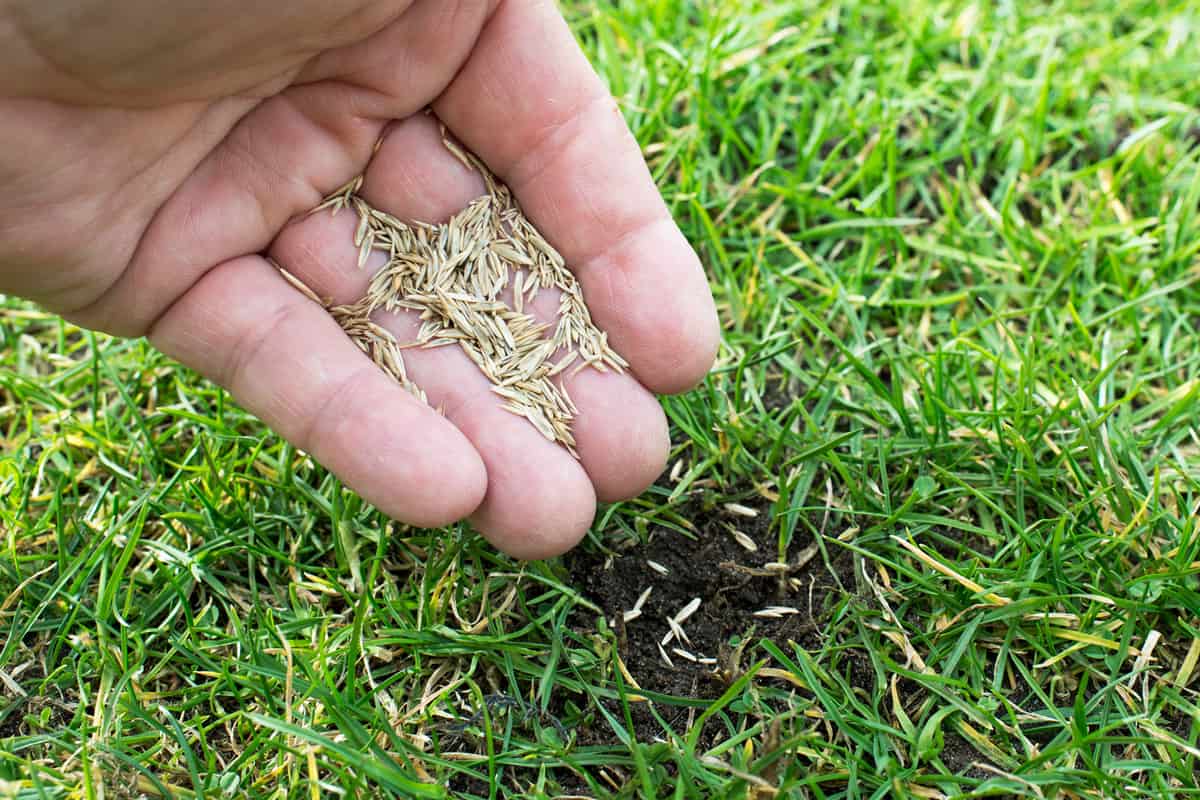Home>Gardening & Outdoor>Landscaping Ideas>When To Plant Grass Seed In Maryland


Landscaping Ideas
When To Plant Grass Seed In Maryland
Modified: September 2, 2024
Discover the best time to plant grass seed in Maryland for a lush, thriving lawn. Get expert landscaping ideas and tips for successful grass seeding.
(Many of the links in this article redirect to a specific reviewed product. Your purchase of these products through affiliate links helps to generate commission for Storables.com, at no extra cost. Learn more)
Best Time to Plant Grass Seed in Maryland
Planting grass seed in Maryland requires careful consideration of the region's climate and weather patterns. The best time to sow grass seed in Maryland is during the late summer to early fall, typically from mid-August to mid-September. This timeframe allows the seeds to germinate and establish before the harsh winter sets in, giving your lawn a head start for the following spring.
During this period, the soil temperature is still warm, which is essential for seed germination. Additionally, the cooler air temperatures reduce the risk of heat stress on the young grass plants. By planting during this optimal window, you can take advantage of the favorable conditions to ensure successful germination and establishment of your grass.
It's important to note that the best time for planting grass seed can vary depending on the specific grass species you intend to grow. For cool-season grasses such as Kentucky bluegrass, fine fescue, and perennial ryegrass, the late summer to early fall window aligns perfectly with their natural growth patterns. These grasses thrive in the cooler temperatures and ample moisture provided by the fall season, allowing them to develop strong root systems before winter dormancy.
On the other hand, warm-season grasses like Bermuda grass and Zoysia grass are better suited for planting in late spring to early summer when the soil has warmed up sufficiently for optimal germination and growth.
Understanding the ideal timing for planting grass seed in Maryland is crucial for achieving a lush and healthy lawn. By aligning your seeding schedule with the natural growth patterns of the grass species, you can maximize the chances of successful establishment and long-term vitality for your lawn.
Key Takeaways:
- Best Time to Plant Grass Seed in Maryland
The best time to plant grass seed in Maryland is late summer to early fall. This gives the seeds a head start before winter, ensuring successful germination and a healthy lawn in the spring. - Factors to Consider Before Planting Grass Seed
Before planting grass seed in Maryland, consider climate, sunlight, maintenance, pests, and water availability. Understanding these factors helps create a resilient and beautiful lawn that thrives in Maryland’s diverse conditions.
Read more: When To Plant Grass In Maryland
Factors to Consider Before Planting Grass Seed
Before embarking on the process of planting grass seed in Maryland, it's essential to carefully assess several key factors that can significantly impact the success of your lawn establishment. By taking these considerations into account, you can make informed decisions and set the stage for a thriving and resilient grass cover.
1. Climate and Soil Conditions
The unique climate and soil characteristics of Maryland play a pivotal role in determining the type of grass seed that will thrive in your specific location. Maryland experiences a diverse climate, ranging from the humid subtropical climate of the eastern shore to the humid continental climate of the western mountains. Understanding the local climate patterns, average temperatures, and precipitation levels is crucial for selecting grass seed varieties that are well-suited to the region's conditions. Additionally, conducting a soil test to assess the pH levels, nutrient content, and soil structure can provide valuable insights for choosing the most appropriate grass species and optimizing soil preparation.
2. Sunlight and Shade
The amount of sunlight and shade in your lawn area is a critical factor to consider when selecting grass seed. Different grass species have varying sunlight requirements, with some thriving in full sun, while others are more shade-tolerant. By evaluating the sun exposure in your yard throughout the day, you can choose grass seed varieties that align with the specific light conditions, ensuring optimal growth and coverage.
3. Maintenance Preferences
Consider your maintenance preferences and the level of care you are willing to dedicate to your lawn. Some grass species may require more frequent mowing, fertilization, and irrigation, while others are more low-maintenance. By aligning the grass seed selection with your maintenance capabilities and preferences, you can establish a lawn that suits your lifestyle and landscaping goals.
Read more: When To Plant Grass Seed Maryland
4. Pest and Disease Resistance
Assessing the prevalent pests and diseases in your area can guide your choice of grass seed varieties with enhanced resistance to local threats. By selecting cultivars known for their pest and disease resistance, you can minimize the risk of lawn damage and reduce the need for chemical interventions, promoting a more sustainable and eco-friendly lawn management approach.
5. Water Availability
Considering the availability of water resources and the potential for drought conditions is crucial for selecting grass seed varieties that can thrive with the available water supply. Choosing drought-tolerant grass species can help conserve water and ensure the long-term resilience of your lawn, especially during periods of water restrictions or limited irrigation capabilities.
By carefully evaluating these factors before planting grass seed in Maryland, you can make informed decisions that align with the local conditions and set the stage for a successful lawn establishment. Understanding the interplay of climate, soil, sunlight, maintenance preferences, pest resistance, and water availability is essential for creating a resilient and visually appealing lawn that enhances the outdoor environment.
Steps to Planting Grass Seed in Maryland
-
Prepare the Soil: Begin by preparing the soil to create an optimal environment for seed germination and root development. Remove any debris, such as rocks and branches, and use a garden rake to level the surface. Conduct a soil test to assess the pH levels and nutrient content, and make any necessary amendments to ensure the soil is well-balanced and fertile.
-
Select the Right Seed: Choose high-quality grass seed that is well-suited to the specific conditions of your lawn area. Consider factors such as sunlight exposure, soil type, and climate resilience when selecting the grass seed varieties. Opt for a blend of grass species to enhance the overall resilience and aesthetic appeal of the lawn.
-
Seed Distribution: Use a broadcast spreader or a handheld spreader to evenly distribute the grass seed across the prepared soil. Follow the recommended seeding rates provided on the seed packaging to achieve the desired coverage. For smaller areas, hand seeding can be done by evenly dispersing the seeds using a sweeping motion.
-
Rake and Press: Gently rake the seeded area to ensure good seed-to-soil contact, which is essential for successful germination. Lightly press the seeds into the soil using a lawn roller or by walking over the area to secure the seeds in place.
-
Fertilize and Water: Apply a starter fertilizer to provide essential nutrients for the germinating seeds and young seedlings. Water the seeded area immediately after planting to ensure the soil is adequately moist. Maintain consistent moisture levels by lightly watering the area multiple times a day, especially during dry or windy conditions.
-
Monitor and Protect: Keep a close eye on the seeded area and ensure that the soil remains consistently moist until the grass seedlings have established. Protect the newly seeded area from foot traffic, heavy machinery, and excessive disturbance to allow the seeds to germinate undisturbed.
-
Mowing and Maintenance: Once the grass seedlings reach a height of 3-4 inches, it's time to mow the lawn for the first time. Set the mower to a higher setting to avoid stressing the young plants. Gradually transition into a regular mowing schedule as the grass establishes, and implement a comprehensive maintenance plan to promote the long-term health and vigor of the lawn.
By following these essential steps, you can effectively plant grass seed in Maryland and set the stage for a vibrant and resilient lawn that enhances the outdoor landscape. Each step plays a crucial role in creating an environment conducive to successful grass seed germination and establishment, ultimately leading to a lush and healthy lawn that thrives in the Maryland climate.
Tips for Maintaining a Healthy Lawn
Maintaining a healthy lawn in Maryland requires ongoing care and attention to ensure that your grass remains lush, vibrant, and resilient throughout the changing seasons. By implementing effective maintenance practices, you can promote the long-term health and beauty of your lawn while minimizing potential issues such as weed infestations, disease outbreaks, and nutrient deficiencies. Here are some valuable tips for maintaining a healthy lawn in Maryland:
Read more: When To Seed Grass In Maryland
1. Regular Mowing
Establish a consistent mowing schedule to keep your lawn at an optimal height for healthy growth. Avoid cutting more than one-third of the grass blade length in a single mowing session to prevent stress on the plants. Adjust the mower height based on the specific grass species and seasonal growth patterns, ensuring that the grass remains at an ideal height for resilience and vigor.
2. Proper Watering
Water your lawn deeply and infrequently to encourage deep root growth and drought tolerance. Early morning is the best time to water the lawn, allowing the grass blades to dry before evening and minimizing the risk of fungal diseases. Adjust the watering frequency based on the weather conditions, aiming to provide around 1-1.5 inches of water per week, including rainfall.
3. Fertilization
Implement a well-planned fertilization schedule to provide essential nutrients for your lawn. Conduct a soil test to determine the specific nutrient requirements and choose a high-quality, slow-release fertilizer that aligns with the grass species and soil conditions. Apply fertilizers at the recommended rates and timings to promote healthy growth without excessive lushness.
4. Weed Control
Regularly inspect your lawn for weeds and implement effective control measures to prevent weed encroachment. Consider using pre-emergent herbicides in the spring to inhibit weed seed germination, and spot-treat any existing weeds with targeted herbicides. Maintaining a dense and healthy turf through proper mowing and fertilization can also help suppress weed growth.
Read more: When To Plant Vinca Seeds
5. Aeration
Periodic core aeration can alleviate soil compaction and improve air, water, and nutrient penetration into the root zone. Consider aerating your lawn in the fall to enhance root development and overall turf health. This process promotes better water absorption and root growth, contributing to a more resilient and vigorous lawn.
6. Overseeding
Overseeding your lawn with grass seed can help fill in thin or bare areas, enhance turf density, and introduce newer, more resilient grass varieties. Choose high-quality grass seed that matches your existing lawn species and overseed in the fall to take advantage of favorable growing conditions for optimal establishment.
7. Pest and Disease Management
Stay vigilant for signs of pest infestations and lawn diseases, and take prompt action to address any issues. Implement integrated pest management strategies to minimize the use of chemical treatments and prioritize natural pest control methods. Regularly inspect your lawn for signs of stress, discoloration, or damage, and seek professional advice if needed.
By incorporating these tips into your lawn care routine, you can nurture a vibrant and resilient lawn that thrives in the diverse climate of Maryland. Consistent maintenance, proper watering, fertilization, and proactive pest management are essential for sustaining a healthy and visually appealing lawn that enhances your outdoor living space.
Frequently Asked Questions about When To Plant Grass Seed In Maryland
Was this page helpful?
At Storables.com, we guarantee accurate and reliable information. Our content, validated by Expert Board Contributors, is crafted following stringent Editorial Policies. We're committed to providing you with well-researched, expert-backed insights for all your informational needs.













0 thoughts on “When To Plant Grass Seed In Maryland”